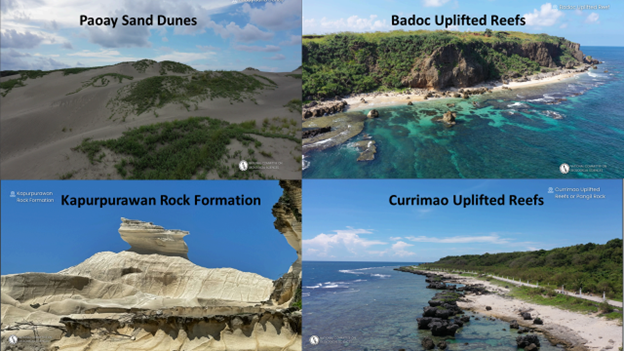The National Committee on Geological Sciences (NCGS), led by the Mines and Geosciences Bureau Central Office (MGB CO) through the General Geology Section of the Lands Geological Survey Division, is currently conducting a geological assessment of Ilocos Norte's natural landmarks from October 1 to 15, 2024. This assessment is part of a broader effort to evaluate geosites across the country. Other key members of the NCGS involved in this initiative include the MGB Regional Office I (MGB RO-I), the National Museum of the Philippines (NMP), and the Department of Environment and Natural Resources - Climate Change Service (DENR-CCS). The activity follows the successful August 1 to 11, 2024 assessment.
About the NCGS
The NCGS was established on October 8, 1980, by Executive Order No. 625, under the Office of the President. The NCGS serves as an advisory body to the government and coordinates efforts among all agencies involved in geological sciences. The MGB, designated as the lead agency, provides funding and operational support to the Committee. Over the years, NCGS has played a crucial role in geological research, assessments, and the promotion of geoheritage across the Philippines.
August 2024 Assessment
From August 1 to 11, 2024, the NCGS, with MGB at the helm, assessed the following geosites in Ilocos Norte:
- Badoc Uplifted Reefs: Witness the power of tectonic activity! These coral reefs, now above sea level, tell the story of geological uplift, relative sea-level changes, and ancient marine environments;
- Currimao Uplifted Reefs: Similar to Badoc, these reefs reveal a record of tectonic movements and sea-level changes over thousands of years, showing how landscapes evolve over geologic time;
- Pasuquin Uplifted Reef and Boulder Field: This site features an expansive uplifted reef and striking large boulders scattered across the landscape, shaped by extreme wave events;
- Paoay and La Paz Sand Dunes: These desert-like landscapes showcase the beauty of wind-formed dunes. The area offers a unique glimpse into how wind, waves, and time shape coastal environments, with significant geological value for studying sediment transport and climate conditions over time; and
- Laoag Sinking Bell Tower: More than just a historical landmark! This tower is a reminder of the subsidence occurring beneath our feet, where geological processes cause gradual sinking in the region.
October 2024 Assessment
From October 1 to 15, 2024, the NCGS team is focusing on additional geosites:
- Kapurpurawan Rock Formation: A striking white rock formation composed of calcarenite, sculpted by wind and waves, standing in visual harmony with towering windmills—an unforgettable landscape of nature and sustainable energy;
- Cape Bojeador Sea Cliffs: Towering volcanic cliffs with panoramic views of the rugged coastline and deep blue sea;
- Kalbario–Patapat Natural Park and Patapat Viaduct: A scenic coastal drive with stunning views of the lush Patapat Mountains and the sparkling ocean—a beautiful meeting of land and sea; and
- Dos Hermanos Melange: One of the oldest rock formations in the Philippines, dating back to the Upper Jurassic – Lower Cretaceous, offering a glimpse into the tectonic processes in the distant geological past.
Local Government Engagement: Focus Group Discussion
After the October assessment, a focus group discussion with the local government will be held to share the findings and explore how these sites can be promoted for education, tourism, and conservation.
Geodiversity Day
As part of this activity, we also recognize the celebration of International Geodiversity Day on October 6, 2024, highlighting the importance of preserving the rich geological features of the planet.

Some Ilocos Norte natural landmarks as potential geosites for geological assessment by the NCGS.
By: Lands Geological Survey Division
